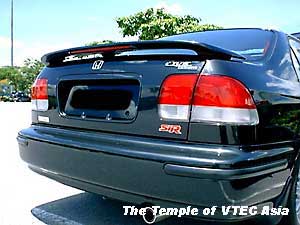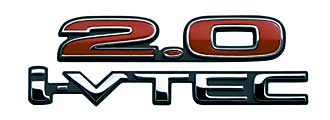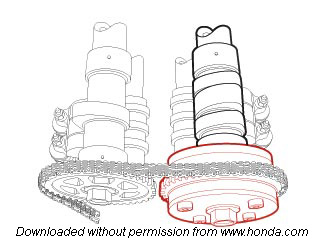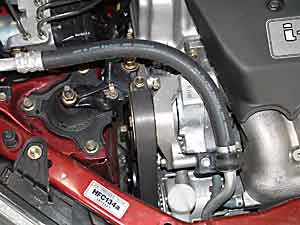
Of all the models in Honda's line-up, the Civic is probably the most important. Over the years, through many generations of excellent variants the Civic has gained a tremendous reputation as a sporty performance model, in the process gardnering legions of loyal fans. I count myself as one of them, having owned three Civics in the past.

Many Civic variants have since gained cult status, the most famous of which must surely be the mighty Honda Civic SiR. Powered by the legendary 1.6l DOHC VTEC B16A engine delivering first 160ps and then 170ps, the Civic SiR was responsible for establishing the Civic as a sports-sedan that is highly respected for its performance abilities. The last generation also saw the introduction of the EK9 Civic Type-R which brings the Civic up another level in performance, only spoilt by virtue of it being a JDM-only variant.
Things went bad when the current generation was launched back in 2000. While the rest of the world were hoping that their fervent request for the mighty Civic SiR would be answered with a global variant, Honda went backwards and actually deleted this variant even from their local JDM line-up ! The only performance Civic now is the EP3 Civic Type-R but it is totally ineffective because Honda continues with its usual frustrating practise of limiting it to a very small market - Europe and JDM only. With only mildly tuned SOHC-VTEC Civics to take on ever improving competitions, it's no surprise that the Civic took a beating and loyal Honda and especially Civic fans abandoned the Civic en masse.
The Civic sunk really low over the last few years, helped no doubt by Honda's stubborn insistence that the Civic Type-R continues to have limited availability. Needless to say, sales and the Civic's reputation itself dropped accordingly. I am sure Honda have since realized their mistake and this was actually confirmed when one of the Honda R&D engineers from Tochigi openly admitted to me that because they wanted to acheive the success of the mighty Toyota Corolla, they actually thought people wanted a Civic that is a Corolla ! And so fine all-round vehicles the SOHC VTEC D17A Civics are, they fatally lacks the crucial DNA that defines the Civics of old. Honda have realized their mistake and while I can assure readers that things will be made right for the next generation, the current one however still have a couple of years life left.

Fortunately for us enthusiasts, Honda Thailand and now Honda Malaysia, in their forward looking vision are not going to sit around and wait that long. So the Honda Civic 2.0 i-VTEC is born. Designed by Honda R&D Asia in Thailand, it is a most significant variant for loyal Honda enthusiasts in general and Civic enthusiasts in particular. It brings hope that the magic of the great legend, the Honda Civic SiR sedan is returning. While Honda Thailand markets the Civic 2.0 i-VTEC as a 2.0l luxury executive sedan, Honda Malaysia goes the other way and markets this Civic 2.0 i-VTEC as their premier sports-sedan for Malaysia. So how does the Civic 2.0 i-VTEC, a variant I like to simply call the 'K20A Civic' perform ? I try my best to answer this question as comprehensively as possible in this review. The test-drive was conducted with utmost care and accordingly this article was written with utmost attention. As a result it took a very long time for me to complete but I hope for those who have been eagerly waiting for this article, the wait will be worthwhile.
As with all my reviews, I start with a quick look at some of the more important technological features of the K20A Civic. Honda's greatest strength is the showcasing of their technological prowness in their cars and this aspect is what Honda enthusiasts loves about their Hondas. For most enthusiasts, the most important element of a car would be its engine and gearbox.

The Civic 2.0 i-VTEC features the extremely desireable K20A engine and a state of the art GLC 5-speed gearbox. The engine is rated for a max power of 155ps at 6500rpm and a max torque of 18.0 kgm at 5000rpm. Redline is at a high 7000rpm. While it is not the highest spec Civic in Honda's line-up, in the context of the current 'ES' generation, this K20A Civic is the highest spec Civic sedan sold anywhere in the world including the Japanese Domestic Market itself. In almost everywhere else the highest spec Civic sedan is still powered by the 130ps D17A SOHC VTEC engine. Even considering all variants available across the world, the only variant which is of equivalent specs would be the 160ps Civic Si 3door hatch of the US Domestic Market and the only variant which has higher (though a lot higher) specs would be the mighty EP3 200/215ps Civic Type-Rs from Europe and the JDM.
The K20A used on this Civic's uses an intake-only VTEC implementation. K20As with intake-only VTEC are used by Honda on a variety of their models, CR-V, Stream and models like the JDM DC5 Integra iS and some Accords as well. These models are more rounded than the all-out hardcore performance models like the Type-Rs. For them outright performance will not be as important as a good power with good fuel economy or a strong mid-range power for e.g. At the moment, Honda has two versions of this intake-only VTEC implementation. One uses 3 rocker-camlobe pairs and the other 2 rocker-camlobe pairs, both on the intake side of course. In both versions, VTEC changes the engine between a 12V to a 16V configuration, i.e. between either 1 intake or 2 intake valves per cylinder by de-activating or activating one of the valves.
According to my conversations with the Honda R&D engineers, apparently the K20A on this Civic uses the 3 rocker-camlobe implementation. In this implementation, there are three rocker/cam-lobe pairs per cylinder for the intake side. The two rocker-arm/cam-lobe pairs on each extremity (i.e. left-most and right-most pairs) are the ones which connects to the intake valves. One of the cam lobes is flat and this 'de-activate' its intake valve during normal operation (so called 'VTEC-off' mode) where all three rocker arms works independently of each other. The other lobe works the remaining valve normally and as a result, the K20A works as if it's a 12V engine, i.e. 1 intake and 2 exhaust per cylinder. Running with only 1 intake valve active induces a swirl in the intake air-flow and helps to completely mix the air-fuel mixture. This improves the efficiency of its combustion which improves fuel economy. In addition, a 12V configuration also deliver good power in the lower rpms. After 4800rpm, VTEC engages and locks all three intake rocker arms together. Both intake valves now works according to the middle rocker/cam-lobe pair which has a higher lift and longer valve opening duration. The K20A now works as if it's a 16V engine but with a wilder, racier intake cam. This helps delivers more power in the higher rpms.

VTC is implemented on the intake camshaft and dynamically change both the intake-exhaust valve opening overlap as well as the relative position of the intake camshaft in relation to the position of the piston. This is done by rotating the intake cam along its axis and delivers both better fuel economy as well as more power from the engine at all rpms. The diagram on the left which I downloaded from the Civic Si page of the AHM (American Honda Motors) website is used to show the VTC mechanism as implemented on the intake cams of the USDM Civic Si's K20A. Very usefully it also shows the 3 intake rocker-camlobe implementation on that engine as well. And as described above, according to what I understand from the japanese R&D engineers, this is also what is used on the Civic 2.0 i-VTEC's K20A.

The K20A uses a single runner intake manifold design. The runner lengths are tuned for optimal torque at high rpm to complement the wild intake cams for 'VTEC-on' operation. Visually the intake manifold used in this K20A is the same design as those on the EP3 Civic Type-R and DC5 Integra Type-R but with a smaller throttle body and quite probably with smaller inner dimensions as well. Actually I think this engine is basically the same as that used on the USDM Civic Si (3door hatch) but tuned for auto gearbox driving. I have always wondered why Honda did not use the dual runners intake manifold from the CR-V/Stream as that gives very high mid-range torque but retains the good high-end as evidenced by the same max power ratings. The formal Honda R&D response was the Civic is a considerably lighter vehicle and being a sports-sedan has a different design objective compared to the SUV/MPV design of the CR-V/Stream. So a flatter, more consistent torque curve was deemed sufficient and more desirable for the Civic at the expense of having lower torque in the mid-range. Eventually there was also an admission that the engine bay of the Civic simply can't accomodate the bulkier dual-runners design. Finally the cooling system remains identical for both 1.7l and 2.0l Civic. This essentially means the radiator, fans, etc are the same for both variants.
The gearbox is a Grades Logic Control equipped 5 speed unit equipped with Progressive Shift technology which helps to ensure seamless and very smooth gear changes. The gearbox incidently is the source of a lot of debates amongst enthusiasts. While it offers 5 gears and thus a lot more flexibility than normal 4ATs, the issue lies in its gear ratios. The ratios are 2.684, 1.500, 0.983, 0.733, and 0.571 for 1st, 2nd, 3rd, 4th and 5th gears respectively. The final drive's ratio is 4.562. Technically versed car enthusiasts quickly noticed the reducing gap as we go from gears 1 to 5. In addition, the ratios for gears 3, 4, and 5 are all below 1.0. This has caused some to actually label these gears as 'over-drive' (because of the rule-of-thumb that their ratio is less than 1.0) and this has led to a great deal of misconception. In this instance, one must not judge the effect of the ratios based just on that one gear alone. One must use what I like to call the effective gear ratio which is derived by multiplying each individual gear's ratio by the ratio of the final drive. In modern gearboxes (both auto and manual), the engine power delivered at the flywheel goes through two sets of gear linkages before getting to the driving wheels. From the flywheel, power goes through the clutch, then to the individual gear selected (either of 1, 2, 3, 4, 5 or R in this case) and then through the final drive before finally arriving at the front wheels via the drive shalf. Therefore the multiplier for engine power/torque from flywheel to front wheels is a combination of each gear's ratio and the final drive ratio. In this case, the important factor is the final drive ratio on this Civic - 4.562 is very high. To set this value in perspective, the previous generation EK9 Civic Type-R uses a 5MT gearbox with a final drive ratio of 'only' 4.400 ! So before we make any judgement of whether an individual gear is over-drive or not, we must first take into account the final drive ratio. For example, the car most commonly used to compare against the K20A Civic is the Ford Lynx RS 2.0. This car uses a 4AT gearbox with gear ratios at 2.826, 1.497, 1.000, 0.730 and a final drive ratio of 4.147. Technically 3rd gear on this gearbox at 1.000 is not an over-drive ratio and when we take the final drive ratio into account, we get an effective ratio of 4.147 for 3rd gear. Compare this with 3rd gear on the K20A Civic where the lower 0.983 ratio is multipled by 4.562 and we get an effective ratio of 4.484. So it is clear which 3rd gear will deliver more drive to the front wheels.
 |
A idler pulley replaces the hydraulic power steering pump with EPS |
Coming to the rest of the car, the K20A Civic comes fully spec'ed as is the norm with cars marketed by Honda Malaysia. In addition to the now standard set of ABS, EBD, BA and dual-SRS, the K20A Civic additionally has EPS (electrical power steering) similar to the City and Jazz. The virtues of EPS has already been explained many times in my reviews of those cars so I won't go through them again. The K20A Civic also uses an automatic air-cond (i.e. what we like to call climate-control) which until now is only available in the luxury oriented models (i.e. Accord, Odyssey, etc).
The K20A engine is quite a bit heavier than the D17A engine which powers all Civic sedans until now. This will skew the front to rear weight distribution towards the front and to accomodate for the heavier front weight bias, the suspension (spring and absorber rates) and anti-roll bars were tuned but the chassis remains essentially identical between the 2.0l and 1.7l version. In terms of this tuning, the Honda R&D engineers were very careful to emphasize to me that the K20A Civic is designed for luxury with performance. They seemed very eager to get this message across and it was only during this review session that I finally understood the reason for it. This will be explained when I do the subjective performance evaluation for this K20A Civic later in this article.
Enough of just looking at the K20A Civic then. The proof of a pudding is in its eating and so for me and I am sure for all readers of this article, the most important parts are to come, the performance evaluations ! But first, befitting its position as Honda Malaysia's premier sporty model and its great importance to us enthusiast, I want to take a special look at how much of it's spec'ed rating the K20A engine really delivers. To do that, I sent the K20A Civic for a dyno-check !